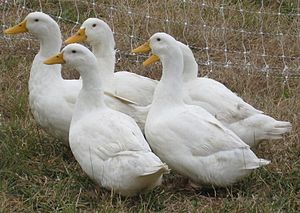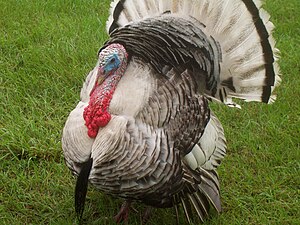Poultry/ja: Difference between revisions
Created page with "細菌は栄養培地で実験室内に培養可能であるが、ウイルスは複製のために生きた細胞を必要とする。多くのワクチンは感染症に対して受精鶏卵内で培養可能である。毎年数百万個の卵が年間インフルエンザワクチンの供給のために使用される。この複雑な過程は、どのウイルス株を新ワクチンに含めるかの決定から約6か月..." |
|||
| (11 intermediate revisions by the same user not shown) | |||
| Line 134: | Line 134: | ||
集約飼育と放し飼いの両方に動物福祉の懸念がある。集約的なシステムでは、[[:en:Cannibalism (poultry)|共食い]]、[[:en:feather pecking|羽つつき]]、[[:en:vent pecking|泄殖孔つつき]]が一般的であり、一部の農家は予防策として[[:en:debeaking|嘴切り]]を用いる。疾病もまた一般的であり、群れの中で急速に広がる可能性がある。広範なシステムでは、鳥は悪天候にさらされ、捕食者や病気を媒介する野鳥に脆弱である。バーンシステムは鳥の福祉が最も悪いとされている。[[:en:Southeast Asia|東南アジア]]では、放し飼い農業における疾病管理の欠如が[[:en:avian influenza|鳥インフルエンザ]]の流行と関連付けられている。 | 集約飼育と放し飼いの両方に動物福祉の懸念がある。集約的なシステムでは、[[:en:Cannibalism (poultry)|共食い]]、[[:en:feather pecking|羽つつき]]、[[:en:vent pecking|泄殖孔つつき]]が一般的であり、一部の農家は予防策として[[:en:debeaking|嘴切り]]を用いる。疾病もまた一般的であり、群れの中で急速に広がる可能性がある。広範なシステムでは、鳥は悪天候にさらされ、捕食者や病気を媒介する野鳥に脆弱である。バーンシステムは鳥の福祉が最も悪いとされている。[[:en:Southeast Asia|東南アジア]]では、放し飼い農業における疾病管理の欠如が[[:en:avian influenza|鳥インフルエンザ]]の流行と関連付けられている。 | ||
==家禽ショー== | |||
多くの国々で、全国的または地域的な家禽ショーが開催され、愛好家が自らの鳥を出展し、それぞれの[[:en:breed standard|品種標準]]で規定された特定の[[:en:phenotype|表現型]]の[[:en:breed|品種]]的特徴に基づいて審査される。家禽展示の発想は、闘鶏が違法となった後、家禽飼育に競争要素を維持する方法として生まれた可能性がある。品種標準は、採卵用、肉用、純粋に観賞用の鳥に対して統一性を目指して作成された。家禽ショーは一般の[[:en:livestock show|家畜ショー]]の一部である場合もあれば、[[:en:Poultry Club of Great Britain|イギリス家禽クラブ]]が主催する「ナショナル・チャンピオンシップ・ショー」のような独立したイベントである場合もある。 | |||
==食用としての家禽== | |||
{{See also/ja|Chicken as food/ja|Duck as food/ja|Goose as food/ja|Turkey as food/ja}} | |||
{{See also|Chicken as food|Duck as food|Goose as food|Turkey as food}} | |||
===取引=== | |||
[[File:HK Central 結志街 Gage Street market 雞蛋 Chicken n 鴨蛋 Duck Eggs on sale March-2012.jpg|thumb|香港で販売されている鶏卵と鴨卵]] | |||
[[File:HK Central 結志街 Gage Street market 雞蛋 Chicken n 鴨蛋 Duck Eggs on sale March-2012.jpg|thumb| | 家禽は世界で2番目に広く食べられている肉の種類であり、世界全体の肉生産量の約30%を占め、[[pork/ja|豚肉]]の38%と比較される。毎年160億羽の鳥が消費のために飼育され、その半分以上が工業化された工場のような生産施設で育てられている。2013年には世界のブロイラー肉生産は8,460万トンに達した。最大の生産国はアメリカ合衆国(20%)、中国(16.6%)、ブラジル(15.1%)、欧州連合(11.3%)であった。生産には2つの異なるモデルが存在する。欧州連合の[[:en:supply chain|サプライチェーン]]モデルは、生産元の農場まで遡ることができる製品供給を目指している。このモデルは、追加的な食品安全要件、動物福祉問題、環境規制の実施に伴うコスト増加に直面している。対照的に、アメリカ合衆国モデルは製品をコモディティ化するものである。 | ||
2011年における世界の鴨肉生産量は約420万トンであり、その3分の2は中国で生産され、約17億羽が飼育されていた。極東で鴨肉の notable な生産国には、ベトナム、タイ、マレーシア、ミャンマー、インドネシア、大韓民国があり、合計で12%を占めていた。フランス(3.5%)は西洋における最大の生産国であり、次いで他のEU諸国(3%)と北アメリカ(1.7%)であった。ガチョウ肉およびホロホロチョウ肉においても中国が圧倒的に最大の生産国であり、世界市場260万トンの94%を占めていた。 | |||
世界の卵生産量は2013年に6,550万トンに達すると予測され、過去のすべての年を上回った。2000年から2010年にかけて、卵の生産は世界的に年間約2%の成長を続けていたが、その後は成長率が1%近くに鈍化した。2018年には卵の生産量は7,670万トンに達し、2008年から24%という大幅な増加を示した。 | |||
===家禽の部位=== | |||
=== | [[File:MIN Rungis volaille.jpg|thumb|フランスの[[:en:Marché d'Intérêt National de Rungis|ランジス国際市場]]の家禽売場]] | ||
[[File:MIN Rungis volaille.jpg|thumb| | 家禽は生鮮または冷凍で、丸ごとの鳥または部位ごとに、骨付きあるいは骨なし、さまざまな方法で味付けされ、生または調理済みで提供される。鳥の最も肉付きの良い部分は胸の[[:en:flight|飛行]][[muscle/ja|筋肉]]で「胸肉」と呼ばれ、また[[:en:walking|歩行]]用の[[leg (anatomy)/ja|脚]]の筋肉である「もも肉」や「ドラムスティック」と呼ばれる部分である。翼も食用にされ(アメリカ合衆国では[[Buffalo wing/ja|バッファローウィング]]が人気の例である)、3つの部位に分けられることがある。すなわち、肉付きのよい「ドラムレット」、別名「フラット」とも呼ばれる「ウィングレット」、そして「フラッパー」とも呼ばれる翼の先端部である。日本では翼が頻繁に分けられ、それぞれ手羽元(''teba-moto'' 「翼の基部」)と手羽先(''teba-saki'' 「翼の先端」)と呼ばれる。 | ||
鳥類の[[:en:myologist|筋肉学者]]が「赤筋」と呼ぶ暗色肉は、持続的な活動、すなわち鶏の場合は主として歩行に用いられる。暗色は細胞内で酸素の取り込みと貯蔵に重要な役割を果たすタンパク質である[[myoglobin/ja|ミオグロビン]]に由来する。これに対して白筋は、鶏の場合は飛行のような短時間の活動にしか適していない。したがって鶏の脚ともも肉は暗色であり、胸肉(主要な飛行筋を構成する)は白色である。アヒルやガチョウのように胸筋が持続的な飛行に適している鳥では、全体に赤筋が存在するため暗色肉となる。家禽を含む一部の肉の部位は、細胞内の[[Myofibrils/ja|筋原線維]]の微細な規則構造を露出させ、光を[[:en:diffraction|回折]]させることで[[:en:iridescent|虹色]]を生じることがあり、この光学現象は[[:en:structural colouration|構造色]]と呼ばれる。 | |||
==健康と疾病(人間)== | |||
[[File:LemonChicken2.jpg|thumb|left|毛をむしられた[[Chicken (food)/ja|鶏肉]]の部位]] | |||
[[File:LemonChicken2.jpg|thumb|left| | |||
2022年当時、家禽の摂取が人間の健康に与える影響について臨床試験で評価されたことはない。家禽の肉と卵は高品質のタンパク質を含み、栄養的に有益な食品である。これは低レベルの脂肪を伴い、有利な脂肪酸構成を有する。鶏肉は重量あたりで大部分の[[red meat/ja|赤身肉]]の約2~3倍の[[polyunsaturated fat/ja|多価不飽和脂肪]]を含む。ただし、皮なしの鶏胸肉ではその量ははるかに少ない。生の鶏胸肉100グラムには脂肪2グラムとタンパク質22グラムが含まれるのに対し、生の[[Cut of beef/ja|牛フランクステーキ]]100グラムには脂肪9グラムとタンパク質20グラムが含まれる。 | |||
2011年の[[:en:Translational Genomics Research Institute|トランスレーショナル・ゲノミクス研究所]]による研究では、アメリカ合衆国の食料品店で販売されている[[meat/ja|肉]]および家禽の47%が''[[Staphylococcus aureus/ja|黄色ブドウ球菌]]''に汚染されており、関与した細菌の52%は少なくとも3種類の抗生物質群に耐性を示した。十分な加熱調理によりこれらの細菌は死滅するが、生の製品を不適切に扱うことで二次汚染のリスクは残る。また、家禽の肉や卵の消費者には、''[[Salmonella/ja|サルモネラ菌]]''や''[[Campylobacter/ja|カンピロバクター]]''などの細菌感染のリスクも存在する。家禽製品は、取り扱い、加工、流通、または保管の過程でこれらの細菌に汚染される可能性があり、適切に調理または扱われなければ[[food-borne illness/ja|食中毒]]を引き起こす。 | |||
一般的に、[[avian influenza/ja|鳥インフルエンザ]]は鳥特有の[[influenza A virus/ja|インフルエンザA型ウイルス]]によって引き起こされる鳥の病気であり、通常は人に感染しない。しかし、生きた家禽と接触する人々はウイルスに感染する最大のリスクを持ち、これは東南アジアのように野鳥集団に[[Endemic (epidemiology)/ja|風土病的]]に存在し、家禽も感染し得る地域で特に懸念される。ウイルスは変異して人間において高病原性かつ高感染性となり、[[influenza pandemic/ja|インフルエンザの世界的大流行]]を引き起こす可能性がある。 | |||
細菌は栄養培地で実験室内に培養可能であるが、ウイルスは複製のために生きた細胞を必要とする。多くの[[vaccine/ja|ワクチン]]は[[infectious disease/ja|感染症]]に対して受精鶏卵内で培養可能である。毎年数百万個の卵が年間インフルエンザワクチンの供給のために使用される。この複雑な過程は、どのウイルス株を新ワクチンに含めるかの決定から約6か月を要する。この方法の問題点は、卵に[[Allergy/ja|アレルギー]]を持つ人々が免疫化できないことであるが、卵ではなく細胞ベースの培養技術が利用可能になることでこの欠点は克服できるかもしれない。細胞ベースの培養は、十分に無菌かつ受精した卵を大量に確保することが困難な[[pandemic/ja|パンデミック]]時にも有用である。 | |||
==関連項目== | ==関連項目== | ||
Latest revision as of 09:26, 28 August 2025

家禽 (/ˈpoʊltri/) は、人間が肉、卵、羽毛などの動物性生産物を得る目的で飼育する家畜化された鳥類である。家禽を飼育する行為は養鶏業として知られている。これらの鳥は、通常は鳥類(特にキジ目に属するニワトリ、ウズラ、七面鳥など)を含むキジカモ目の構成員である。また、カモやガチョウなどカモ科に属する水禽も含まれるが、食料として狩猟される猟鳥やジビエは含まれない。
現存する4種のヤケイを対象とする最近のゲノミクス研究は、最も個体数の多い家禽種であるニワトリの家畜化が、約8,000年前に東南アジアで起こったことを示す。これは以前には、同じく東南アジアで約5,400年前に起こったと考えられていた。この過程は、当初は野生から採取した卵を孵化させて幼鳥を育てることによって生じた可能性があるが、のちには鳥を恒久的に飼育下に置くことを伴うようになった。家畜化されたニワトリは初めは闘鶏に用いられ、ウズラは鳴き声のために飼われた可能性があるが、人々はやがて飼育下繁殖による食料源を持つ利点に気づいた。急速な成長、産卵能力、体型、羽色、従順さに関する選択育種が数世紀にわたって行われ、現代の品種はしばしば野生の祖先とは大きく異なる外見をしている。いまだに一部の鳥は広範な飼養体系において小規模な群れで飼われているが、今日市場で入手可能な大多数の鳥は集中的な商業事業で飼育されている。
豚肉と並んで、家禽は世界で最も広く食べられている2種類の肉のひとつであり、2012年には両者で肉供給の70%以上を占めていた。家禽は高品質のタンパク質を含み、脂肪の割合が低い栄養上有益な食料を提供する。すべての家禽肉は、食中毒のリスクを減らすために適切に取り扱い、十分に調理されるべきである。家禽のみを肉の唯一の供給源として摂取するセミベジタリアンは、ポロタリアニズムを実践しているとされる。
語源
「poultry」という語は、中英語の pultry または pultrie に由来し、これはさらに古フランス語/ノルマン語の pouletrie に由来する。未成熟な家禽を指す若雌鶏という語は、その二重語である poult と同様に、中英語 pulet および古フランス語 polet に由来し、どちらもラテン語の pullus(幼い鳥または幼い動物を意味する)に遡る。語「fowl」はゲルマン語派起源であり(古英語 Fugol、ドイツ語 Vogel、デンマーク語 Fugl に比較される)。
定義
「Poultry」は、いかなる種類の家畜化された鳥でも、その有用性のために飼育下で繁殖されたものを指す用語であり、伝統的にこの語は野禽(キジ目)や水禽(カモ目)を指すが、かご鳥、例えば鳴禽やオウムは含まない。「Poultry」は、肉や卵の生産のために飼育される家禽、すなわちニワトリ、七面鳥、ガチョウ、カモを含む家禽類として定義でき、また食用として用いられるこれらの鳥の肉を指す語としても用いられる。
The Encyclopædia Britannica は同じ鳥類群を挙げているが、ホロホロチョウやスカウォブ(若いハト)も含めている。R. D. Crawford の『Poultry breeding and genetics』ではスカウォブは除外されているが、日本ウズラとコウライキジが追加されており、後者はしばしば飼育下で繁殖されて野に放たれる。Edmund Dixon の1848年の古典的著作『Ornamental and Domestic Poultry: Their History, and Management』には、クジャク、ホロホロチョウ、コブハクチョウ、シチメンチョウ、各種のガチョウ、ムスコビーダック、その他のカモ類、バンタムを含むあらゆる種類のニワトリに関する章が含まれている。
口語では、「fowl」という語はしばしば「家畜化されたニワトリ」(Gallus gallus)や「家禽」あるいは単に「鳥」とほぼ同義に用いられ、多くの言語では「poultry」と「fowl」を区別しない。両語はこれらの鳥の肉を指すためにも用いられる。家禽は「game」と区別され、これは食料またはスポーツのために狩猟される野鳥や哺乳類を意味し、これらを食べる際の肉を表す語としても用いられる。
例
| 鳥 | 野生の祖先 | 家畜化 | 利用 | 画像 |
|---|---|---|---|---|
| ニワトリ | セキショクヤケイ | 南および東南アジア | 卵と肉 | 
|
| 七面鳥 | 野生のシチメンチョウ | メキシコ | 肉 | 
|
| 家禽ウズラ | ウズラ | 各地 | 卵と肉 | 
|
| アヒル | マガモ | 各地 | 卵、肉、羽毛 | 
|
| ガチョウ | ハイイロガン | 各地 | 卵、肉、羽毛 | 
|
| ホロホロチョウ | ホロホロチョウ | アフリカ | 卵と肉 | 
|
| 家鳩 | カワラバト | ユーラシア | 肉 | 
|
ニワトリ

ニワトリは中型でずんぐりした体格をもち、直立姿勢をとる鳥で、頭部に赤い肉質の鶏冠と肉垂を備えることが特徴である。雄(cock)は通常、雌(hen)よりも大きく、より大胆な体色を示し、雌より誇張された羽装をもつ。ニワトリは群生的な雑食性の地上性鳥類であり、自然環境では落ち葉の中で種子、無脊椎動物、その他の小動物を探して採食する。接近されると下生えに走り込むことを好み、知覚された危険による場合を除き、めったに飛翔しない。今日の家禽ニワトリ(Gallus gallus domesticus)は、主としてアジアの野生セキショクヤケイに由来し、さらにハイイロヤケイ、スリランカヤケイ、ミドリヤケイからの追加的な寄与がある。
ゲノム研究は、ニワトリの家畜化が約8,000年前に東南アジアで起こり、その2,000~3,000年後に中国およびインドへ広がったと推定している。考古学的証拠は、東南アジアでは紀元前6000年より前、中国では紀元前6000年までに、インドでは紀元前2000年までに家禽ニワトリが存在したことを支持する。2020年の画期的なNature誌の研究で、世界各地の863羽のニワトリの全ゲノム配列が解読され、すべての家禽ニワトリが、現在の分布が主に中国南西部、タイ北部、ミャンマーにあるセキショクヤケイの単一の家畜化事象に由来することが示唆された。これらの家禽化ニワトリは東南アジアおよび南アジアに広がり、在来の野生ヤケイ類と交雑して、遺伝的かつ地理的に異なる集団を形成した。最も普及している商業品種の解析では、白色レグホーンはセキショクヤケイの亜種から継承された多様な祖先系統がモザイク状に存在することが示されている。
ニワトリは、家畜化動物として海上のオーストロネシアの移住に伴い、台湾、島嶼東南アジア、島嶼メラネシア、マダガスカル、太平洋諸島へ運ばれ、紀元前3500年から2500年頃に始まったとされる。
紀元前2000年までにニワトリはインダス流域に到達し、その250年後にエジプトへ達した。彼らは依然として闘鶏に用いられ、繁殖の象徴と見なされた。ローマ人は占いに用い、エジプト人は人工的な孵化という困難な技術を習得して画期的進歩を遂げた。それ以降、ニワトリの飼育は食料生産のために世界中へ広まり、家禽は卵と肉の双方の重要な供給源となった。
家畜化以来、数多くのニワトリ品種が確立されたが、白色レグホーンを除き、商業鶏の大半は雑種起源である。およそ1800年に飼育は大規模化し、近代的な高生産の養鶏場は1920年頃にはイギリスに存在し、第二次世界大戦後まもなくアメリカ合衆国でも確立した。20世紀半ばまでには、家禽肉生産産業が採卵産業より重要になった。家禽育種は多様な需要を満たす品種・系統を生み出しており、年間300個の卵を産む軽量の採卵鶏、若齢での消費を目的とした急成長で肉付きの良い鶏、そして卵数と肉付きの双方が実用的な鶏などがある。雄鶏は採卵産業では望まれず、孵化直後に識別され淘汰されることが多い。肉用種では攻撃性を防ぐため、しばしば(化学的去勢を含め)去勢されることがあり、その結果生じる鳥はカポンと呼ばれ、肉はより柔らかく風味も良い。

チャボは家禽ニワトリの小型品種であり、標準品種のミニチュア版か、対応する大型種をもたない「真のチャボ」である。この名称はジャワのバンテンの町に由来し、そこで欧州の船乗りが船上補給のために地元の小型鶏を購入したことにちなむ。チャボは標準種の4分の1から3分の1の大きさで、同様に小さな卵を産む。小規模農家や愛好家により、採卵、抱卵用、観賞用、ショー用として飼育されている。
闘鶏
闘鶏は世界最古の観戦型スポーツといわれる。成熟した雄(cockまたはrooster)2羽が闘わされ、いずれかが重篤な傷を負うか死亡するまで激しく戦う。闘鶏は島嶼東南アジアで極めて広く行われ、賭博であると同時に儀礼的な意味を持つこともしばしばであった。また古代インド、中国、ペルシャ、ギリシャ、ローマの文化にも見られ、勝敗により多額の金銭が得失された。アシール種のような品種は、その攻撃性のためインド亜大陸で闘鶏向けに改良された。動物虐待の観点から、過去1世紀の間に多くの国で闘鶏は禁じられている。
カモ
カモは中型の水鳥で、幅広いくちばし、頭部の側方に位置する眼、かなり長い首、体の後方に位置する短い脚、そして水かきのある足をもつ。雄(drake)は雌(hen)より大きいことが多く、品種によっては羽色が異なる。家禽アヒルは雑食であり、水生昆虫、軟体動物、ミミズ、小型両生類、水草、草など多様な動植物を食べる。浅い水域で嘴先採食(ダブリング)を行い、頭部を水中に入れ尾を上に向けて採餌する。多くの家禽アヒルは重すぎて飛翔できず、群居性が高く、群れで生活し移動することを好む。彼らは羽づくろいにより羽毛を防水し、これは尾脂腺の分泌物を羽毛全体に塗布する過程である。

中国で発見された紀元前4000年に遡るカモの土製模型は、仰韶文化の時期にそこで家禽化が行われた可能性を示す。仮にそうでないとしても、カモの家禽化は少なくとも西洋より1500年早く極東で起こった。紀元前1世紀に著述したルキウス・コルメラは、カモを飼育しようとする者には、野鳥の卵を抱卵する雌鶏の下に置くよう助言している。こうして育てられたカモは「野性を捨て、鳥小屋に閉じ込められてもためらいなく繁殖する」からである。にもかかわらず、西ヨーロッパの農業文献にカモが現れるのは約810年になってからであり、その頃からガチョウ、ニワトリ、クジャクと並んで、小作人が地主に支払う地代の対象として言及され始めた。
広く合意されているところでは、マガモ(Anas platyrhynchos)がすべての家禽アヒル品種の祖先である(ただしバリケン(Cairina moschata)は例外で、他のアヒルと近縁ではない)。アヒルは主として肉、卵、ダウンのために飼育される。ニワトリの場合と同様、採卵能力、成長速度、体の充実度に基づいてさまざまな品種が作出されてきた。イギリスおよびアメリカ合衆国で最も一般的な商業品種はペキンアヒルであり、年間200個の卵を産み、44日で3.5 kg (7 lb 11 oz)に達する。西洋世界では、ニワトリの方が白く脂肪分の少ない肉をより大量に生産でき、集約飼育もしやすいため、鶏肉の価格はカモ肉より低い。オート・キュイジーヌでは人気がある一方で、大衆的食品産業での登場頻度は低い。しかし東方では事情が異なる。そこではニワトリよりカモの方が人気であり、主として伝統的な方法で放牧され、収穫後の水田や他の湿潤環境で自力採食できる能力に基づいて選抜されている。
ガチョウ

ハイイロガン(Anser anser)は少なくとも3000年前にエジプトで家禽化され、別の野生種であるサワラガン(Anser cygnoides)は約1000年後にシベリアで家禽化され、シナガチョウとして知られる。両者は互いに交雑し、シナガチョウの顕著な特徴である嘴基部の大きなこぶは、これらの雑種にも程度の差はあれ現れる。雑種は繁殖力をもち、いくつかの現代品種の成立をもたらした。早期に家禽化されたにもかかわらず、ガチョウが商業的重要性でニワトリやアヒルに並ぶことはなかった。
家禽ガチョウは野生の同属種よりはるかに大型で、太い首、直立姿勢、後躯の幅広い大きな体をもつ。ハイイロガン由来の鳥は大型で肉用に適し、シナガチョウは体格が小さく主として採卵に用いられる。両系統の細かな綿羽は枕や中綿衣料に重宝される。草や雑草を採食し、これを小型無脊椎動物で補うため、草地中心の飼養体系で成長しやすい点が飼育の魅力である。非常に群居性が強く記憶力に優れ、日没までに帰巣するため、広範な放し飼いが可能である。シナガチョウは他のガチョウより攻撃的で騒々しく、侵入者の警戒を知らせる番鳥として用いられることがある。肉用ガチョウの肉は暗色でタンパク質に富むが、皮下に脂肪を蓄える。ただしこの脂肪は主に一価不飽和脂肪酸である。屠殺はおおむね生後約10週または約24週で行われるが、この間は生え替わりつつある筆毛のため、羽毛処理に支障が生じる。
一部の国では、ガチョウやアヒルに強制給餌を行い、脂肪含有量の非常に高い肝臓を作ってフォアグラを生産する。世界生産の75%以上はフランスで行われ、ハンガリーとブルガリアにも小規模な産業があり、中国では生産が拡大している。フォアグラは多くの地域で高級食材と見なされているが、この手法は動物福祉上の理由から多くの国で禁止されている。
シチメンチョウ

シチメンチョウは大型の鳥であり、最も近縁なのはキジやホロホロチョウである。雄は雌よりも大きく、広がった扇形の尾と、求愛行動に用いられるくちばしの上から垂れ下がる独特の柔らかい肉垂(スヌードと呼ばれる)をもつ。野生のシチメンチョウは飛ぶことができるが、滅多に飛ばず、長い歩幅で走ることを好む。彼らは木にとまり、地上で採食し、種子、木の実、ベリー、草、葉、無脊椎動物、トカゲ、小さなヘビを食べる。
現代の飼いシチメンチョウは、現在のメキシコのハリスコ州、ゲレーロ州、ベラクルス州に分布する6つの亜種の野生シチメンチョウ(Meleagris gallopavo)の一つに由来する。メキシコ中南部のアステカ以前の部族が紀元前800年頃にこの鳥を最初に家畜化し、アメリカ合衆国のコロラド高原に住んでいたプエブロ族も紀元前200年頃に同様のことを行った。彼らは羽毛を衣服や毛布、儀式に用いた。1000年以上後には、重要な食料源となった。最初にこの鳥に出会ったヨーロッパ人は、それをホロホロチョウと誤認した。当時、ホロホロチョウはトルコ経由でヨーロッパに導入されていたため「ターキーファウル」と呼ばれていたのである。
商業用のシチメンチョウは通常、管理された環境下で屋内飼育される。これらは大規模な建物であることが多く、換気と弱い照明を備えており(これにより活動が抑えられ、体重増加率が高まる)、照明は24時間点灯、または段階的な点灯スケジュールで頻繁に採食を促し、急速な成長を可能にする。雌は約15週齢、雄は約19週齢で食肉用の体重に達する。成長した商業用の鳥は野生の個体の2倍の重さになることもある。多くの品種が作出されてきたが、商業用の鳥の大半は白色であり、これは解体後の外観を良くし、羽鞘が目立ちにくくなるためである。かつてシチメンチョウは主にクリスマス(イギリスでは1000万羽)や感謝祭(アメリカ合衆国では6000万羽)といった特別な機会に消費されていた。しかし現在では、世界の多くの地域で日常的な食事の一部となりつつある。
その他の家禽
ホロホロチョウは南部アフリカを原産とし、家禽として最も飼育される種はホロホロチョウ(ホロホロチョウ属)(Numida meleagris)である。これは中型の灰色または斑点模様の鳥であり、小さな裸の頭に色鮮やかな肉垂と頭頂の突起をもつ。古代ギリシャ人やローマ人の時代までにはすでに家畜化されていた。ホロホロチョウは丈夫で社交的な鳥であり、主に昆虫を食べるが、草や種子も摂取する。彼らは菜園を害虫から守り、ライム病を媒介するマダニを食べる。喜んで木にとまり、捕食者の接近に対して大声で警告を発する。肉や卵はニワトリと同様に食用とされ、若鳥は約4か月齢で食用に適する。
スクウォブとは、食用に供される家鳩の幼鳥を指す名称である。他の飼い鳩と同様に、この用途に用いられる鳥はカワラバト(Columba livia)に由来する。特別な実用種が望ましい特性をもつものとして利用される。卵は2個産まれ、約17日間抱卵される。孵化すると、スクウォブは両親から嗉嚢で生成される高タンパク質の濃厚な分泌物「ピジョンミルク」で育てられる。スクウォブは急速に成長するが、羽毛が生え揃うのは遅く、26~30日齢で巣立ち可能となり、体重は約500 g (1 lb 2 oz)に達する。この頃には親鳩はすでに次の卵を産み、抱卵しており、繁殖期が数か月続く間、多産のつがいは4週間ごとに2羽のスクウォブを生産する。
家禽の飼育


世界的に、他のいかなる家禽よりも多くのニワトリが飼育されており、年間500億羽以上が肉と卵の供給源として飼育されている。伝統的には、これらの鳥は日中に採食し夜間に収容される小規模な群れとして広く飼育されていた。これは発展途上国では今も見られ、女性が家禽飼育を通じて家計に重要な貢献をする場合が多い。しかし、世界人口の増加と都市化により、生産の大部分はより大規模で集約的な専門施設に移行した。これらはしばしば飼料生産地や肉の需要地の近くに設置され、都市部に安価で安全な食料を供給する結果となっている。生産の収益性は飼料価格に大きく依存しており、飼料価格は上昇している。高コストの飼料は、家禽生産のさらなる発展を制限する可能性がある。
放し飼い方式では、鳥は少なくとも1日の一部を屋外で自由に歩き回ることができる。多くの場合、大きな囲いの中であるが、鳥は自然な環境に接し、本来の行動を示すことができる。より集約的な方式はヤーディングであり、鳥は囲い付きの庭と鶏舎にアクセスでき、より高密度で飼育される。家禽はまたバーンシステムで飼育されることもあり、この場合屋外へのアクセスはないが、建物内で自由に動き回ることができる。採卵用ニワトリにとって最も集約的な方式はバタリーケージであり、多段に設置されることが多い。この中では複数羽の鳥が小さなケージを共有し、自由に動くことや通常の行動をとることが制限される。卵はケージの床に産み落とされ、外部の溝に転がり集卵が容易になる。EUでは2012年1月1日以降、採卵鶏用のバタリーケージは違法となっている。

肉用として集約的に飼育されるニワトリは「ブロイラー」と呼ばれる。品種改良により、6週間以内に2 kg or 4 lb 7 ozの解体適正体重に達するよう育成されている。ブロイラーは非常に急速に成長するため、脚が体重を支えられなかったり、心臓や呼吸器系が発達する筋肉に十分な酸素を供給できない場合がある。死亡率は1%で、18週間を要して同等の体重に達するより低集約的な採卵鶏に比べてはるかに高い。処理はコンベヤーベルトの効率で自動的に行われ、鳥は足で吊され、気絶、屠殺、放血、熱湯処理、羽抜き、頭部と足の切除、内臓除去、洗浄、冷却、排水、計量、包装が、わずか2時間強のうちに行われる。
集約飼育と放し飼いの両方に動物福祉の懸念がある。集約的なシステムでは、共食い、羽つつき、泄殖孔つつきが一般的であり、一部の農家は予防策として嘴切りを用いる。疾病もまた一般的であり、群れの中で急速に広がる可能性がある。広範なシステムでは、鳥は悪天候にさらされ、捕食者や病気を媒介する野鳥に脆弱である。バーンシステムは鳥の福祉が最も悪いとされている。東南アジアでは、放し飼い農業における疾病管理の欠如が鳥インフルエンザの流行と関連付けられている。
家禽ショー
多くの国々で、全国的または地域的な家禽ショーが開催され、愛好家が自らの鳥を出展し、それぞれの品種標準で規定された特定の表現型の品種的特徴に基づいて審査される。家禽展示の発想は、闘鶏が違法となった後、家禽飼育に競争要素を維持する方法として生まれた可能性がある。品種標準は、採卵用、肉用、純粋に観賞用の鳥に対して統一性を目指して作成された。家禽ショーは一般の家畜ショーの一部である場合もあれば、イギリス家禽クラブが主催する「ナショナル・チャンピオンシップ・ショー」のような独立したイベントである場合もある。
食用としての家禽
取引

家禽は世界で2番目に広く食べられている肉の種類であり、世界全体の肉生産量の約30%を占め、豚肉の38%と比較される。毎年160億羽の鳥が消費のために飼育され、その半分以上が工業化された工場のような生産施設で育てられている。2013年には世界のブロイラー肉生産は8,460万トンに達した。最大の生産国はアメリカ合衆国(20%)、中国(16.6%)、ブラジル(15.1%)、欧州連合(11.3%)であった。生産には2つの異なるモデルが存在する。欧州連合のサプライチェーンモデルは、生産元の農場まで遡ることができる製品供給を目指している。このモデルは、追加的な食品安全要件、動物福祉問題、環境規制の実施に伴うコスト増加に直面している。対照的に、アメリカ合衆国モデルは製品をコモディティ化するものである。
2011年における世界の鴨肉生産量は約420万トンであり、その3分の2は中国で生産され、約17億羽が飼育されていた。極東で鴨肉の notable な生産国には、ベトナム、タイ、マレーシア、ミャンマー、インドネシア、大韓民国があり、合計で12%を占めていた。フランス(3.5%)は西洋における最大の生産国であり、次いで他のEU諸国(3%)と北アメリカ(1.7%)であった。ガチョウ肉およびホロホロチョウ肉においても中国が圧倒的に最大の生産国であり、世界市場260万トンの94%を占めていた。
世界の卵生産量は2013年に6,550万トンに達すると予測され、過去のすべての年を上回った。2000年から2010年にかけて、卵の生産は世界的に年間約2%の成長を続けていたが、その後は成長率が1%近くに鈍化した。2018年には卵の生産量は7,670万トンに達し、2008年から24%という大幅な増加を示した。
家禽の部位

家禽は生鮮または冷凍で、丸ごとの鳥または部位ごとに、骨付きあるいは骨なし、さまざまな方法で味付けされ、生または調理済みで提供される。鳥の最も肉付きの良い部分は胸の飛行筋肉で「胸肉」と呼ばれ、また歩行用の脚の筋肉である「もも肉」や「ドラムスティック」と呼ばれる部分である。翼も食用にされ(アメリカ合衆国ではバッファローウィングが人気の例である)、3つの部位に分けられることがある。すなわち、肉付きのよい「ドラムレット」、別名「フラット」とも呼ばれる「ウィングレット」、そして「フラッパー」とも呼ばれる翼の先端部である。日本では翼が頻繁に分けられ、それぞれ手羽元(teba-moto 「翼の基部」)と手羽先(teba-saki 「翼の先端」)と呼ばれる。
鳥類の筋肉学者が「赤筋」と呼ぶ暗色肉は、持続的な活動、すなわち鶏の場合は主として歩行に用いられる。暗色は細胞内で酸素の取り込みと貯蔵に重要な役割を果たすタンパク質であるミオグロビンに由来する。これに対して白筋は、鶏の場合は飛行のような短時間の活動にしか適していない。したがって鶏の脚ともも肉は暗色であり、胸肉(主要な飛行筋を構成する)は白色である。アヒルやガチョウのように胸筋が持続的な飛行に適している鳥では、全体に赤筋が存在するため暗色肉となる。家禽を含む一部の肉の部位は、細胞内の筋原線維の微細な規則構造を露出させ、光を回折させることで虹色を生じることがあり、この光学現象は構造色と呼ばれる。
健康と疾病(人間)

2022年当時、家禽の摂取が人間の健康に与える影響について臨床試験で評価されたことはない。家禽の肉と卵は高品質のタンパク質を含み、栄養的に有益な食品である。これは低レベルの脂肪を伴い、有利な脂肪酸構成を有する。鶏肉は重量あたりで大部分の赤身肉の約2~3倍の多価不飽和脂肪を含む。ただし、皮なしの鶏胸肉ではその量ははるかに少ない。生の鶏胸肉100グラムには脂肪2グラムとタンパク質22グラムが含まれるのに対し、生の牛フランクステーキ100グラムには脂肪9グラムとタンパク質20グラムが含まれる。
2011年のトランスレーショナル・ゲノミクス研究所による研究では、アメリカ合衆国の食料品店で販売されている肉および家禽の47%が黄色ブドウ球菌に汚染されており、関与した細菌の52%は少なくとも3種類の抗生物質群に耐性を示した。十分な加熱調理によりこれらの細菌は死滅するが、生の製品を不適切に扱うことで二次汚染のリスクは残る。また、家禽の肉や卵の消費者には、サルモネラ菌やカンピロバクターなどの細菌感染のリスクも存在する。家禽製品は、取り扱い、加工、流通、または保管の過程でこれらの細菌に汚染される可能性があり、適切に調理または扱われなければ食中毒を引き起こす。
一般的に、鳥インフルエンザは鳥特有のインフルエンザA型ウイルスによって引き起こされる鳥の病気であり、通常は人に感染しない。しかし、生きた家禽と接触する人々はウイルスに感染する最大のリスクを持ち、これは東南アジアのように野鳥集団に風土病的に存在し、家禽も感染し得る地域で特に懸念される。ウイルスは変異して人間において高病原性かつ高感染性となり、インフルエンザの世界的大流行を引き起こす可能性がある。
細菌は栄養培地で実験室内に培養可能であるが、ウイルスは複製のために生きた細胞を必要とする。多くのワクチンは感染症に対して受精鶏卵内で培養可能である。毎年数百万個の卵が年間インフルエンザワクチンの供給のために使用される。この複雑な過程は、どのウイルス株を新ワクチンに含めるかの決定から約6か月を要する。この方法の問題点は、卵にアレルギーを持つ人々が免疫化できないことであるが、卵ではなく細胞ベースの培養技術が利用可能になることでこの欠点は克服できるかもしれない。細胞ベースの培養は、十分に無菌かつ受精した卵を大量に確保することが困難なパンデミック時にも有用である。
関連項目
| この記事は、クリエイティブ・コモンズ・表示・継承ライセンス3.0のもとで公表されたウィキペディアの項目Poultry(28 June 2025, at 22:13編集記事参照)を翻訳して二次利用しています。 |


